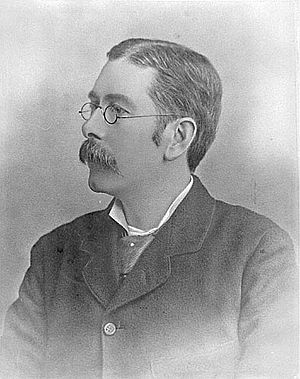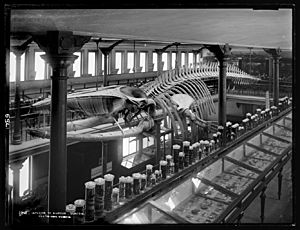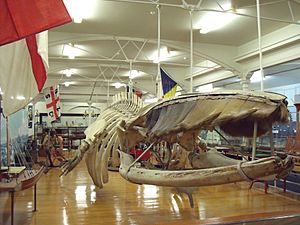Thomas Jeffery Parker facts for kids
Quick facts for kids
Thomas Jeffery Parker
|
|
|---|---|
 |
|
| Born | 17 October 1850 London, England
|
| Died | 7 November 1897 (aged 47) |
| Spouse(s) |
Charlotte Elizabeth Rossell
(m. 1874) |
| Scientific career | |
| Fields | Zoology |
| Institutions | University of Otago Otago Museum |
Thomas Jeffery Parker (born October 17, 1850 – died November 7, 1897) was an important zoologist who worked in New Zealand. He was known for his studies of animals, especially those found in New Zealand, like the moa and the kiwi. He also helped set up the Otago Museum and taught many students about zoology.
Contents
A Life of Discovery
Thomas Jeffery Parker was born in London, England, on October 17, 1850. His father, William Kitchen Parker, was also a scientist who studied anatomy. Thomas went to Clarendon House School and later graduated from the University of London in 1868.
When he was 22, Parker started working with a famous scientist named Thomas Henry Huxley. Huxley was known for his work in zoology. Parker helped him create teaching collections and organize lab lessons for students.
Working with Huxley sparked Parker's interest in crustaceans, which are animals like crabs and lobsters. He later studied the "crayfish" of New Zealand, which are actually a type of spiny lobster. He worked on this with his student, Josephine Gordon Rich.
Moving to New Zealand
On December 23, 1874, Thomas Jeffery Parker married Charlotte Elizabeth Rossell. In 1880, they moved to New Zealand. Parker became a Professor of Zoology at the University of Otago in Dunedin. He took over from another scientist named Frederick Hutton.
Parker also became the curator of the Otago Museum. He was the first trained biologist to work in the country. This meant he had special skills in studying living things.
Parker loved collecting skeletons. He sent a display of animal skulls to the Melbourne International Exhibition in 1880. This display showed how the skulls of different animals had changed over time. He used colored wires and painted bones to make it clear.
In 1883, Parker got a huge fin whale skeleton. He bought it from a man named William Jackson Barry. This fin whale skeleton is still a main attraction at the Maritime Gallery today.
Later Life and Achievements
On June 7, 1888, Parker was made a Fellow of the Royal Society. This is a very high honor for scientists in the United Kingdom.
In his later years, Parker had a health condition called diabetes. He passed away on November 7, 1897, in Warrington. After his death, William Blaxland Benham took over his role at the University of Otago.
His Scientific Work
Thomas Jeffery Parker wrote more than 40 scientific papers. These papers shared his discoveries and research with other scientists.
Studies of New Zealand Animals
He wrote nine papers about moas, which were large, flightless birds that used to live in New Zealand. He also wrote a long book about the history of the kiwi, another unique New Zealand bird. This book was later made shorter into two articles.
Soon after arriving in Dunedin, Parker identified a new species of sea cucumber. He named it Chirodota dunedinensis, which is now called Taeniogyrus dunedinensis.
Parker also wrote a textbook about zoology with William Aitcheson Haswell. This book was used by students for many years, even into the 1960s.
Books by Thomas Jeffery Parker
- Zoötomy (1884)
- Lessons in Elementary Biology (1890)
- A Textbook of Zoology (1897) (written with William A. Haswell)
Animal Named After Him
An oarfish, a long, thin fish that lives in deep waters, was named in his honor. It is called Agrostichthys parkeri. It was named by William Blaxland Benham in 1904.



